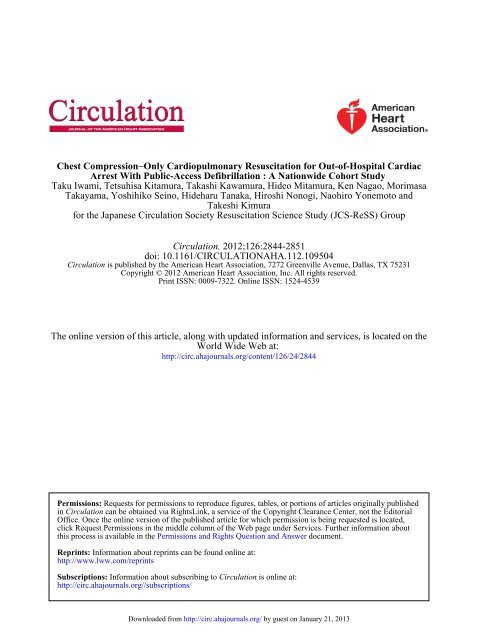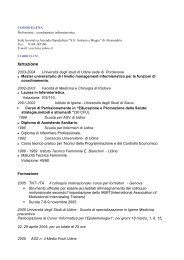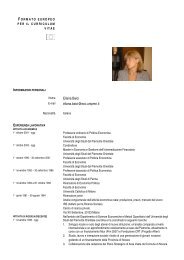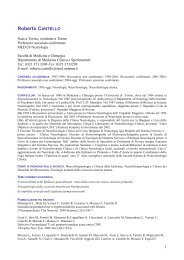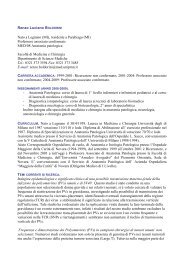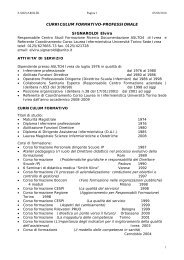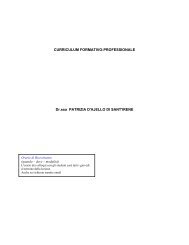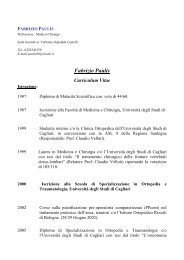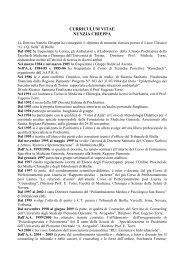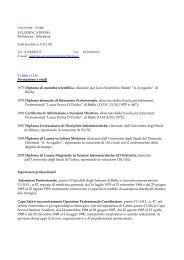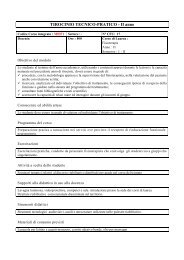for the Japanese Circulation Society Resuscitation Science Study ...
for the Japanese Circulation Society Resuscitation Science Study ...
for the Japanese Circulation Society Resuscitation Science Study ...
Create successful ePaper yourself
Turn your PDF publications into a flip-book with our unique Google optimized e-Paper software.
Chest Compression−Only Cardiopulmonary <strong>Resuscitation</strong> <strong>for</strong> Out-of-Hospital CardiacArrest With Public-Access Defibrillation : A Nationwide Cohort <strong>Study</strong>Taku Iwami, Tetsuhisa Kitamura, Takashi Kawamura, Hideo Mitamura, Ken Nagao, MorimasaTakayama, Yoshihiko Seino, Hideharu Tanaka, Hiroshi Nonogi, Naohiro Yonemoto andTakeshi Kimura<strong>for</strong> <strong>the</strong> <strong>Japanese</strong> <strong>Circulation</strong> <strong>Society</strong> <strong>Resuscitation</strong> <strong>Science</strong> <strong>Study</strong> (JCS-ReSS) Group<strong>Circulation</strong>. 2012;126:2844-2851doi: 10.1161/CIRCULATIONAHA.112.109504<strong>Circulation</strong> is published by <strong>the</strong> American Heart Association, 7272 Greenville Avenue, Dallas, TX 75231Copyright © 2012 American Heart Association, Inc. All rights reserved.Print ISSN: 0009-7322. Online ISSN: 1524-4539The online version of this article, along with updated in<strong>for</strong>mation and services, is located on <strong>the</strong>World Wide Web at:http://circ.ahajournals.org/content/126/24/2844Permissions: Requests <strong>for</strong> permissions to reproduce figures, tables, or portions of articles originally publishedin <strong>Circulation</strong> can be obtained via RightsLink, a service of <strong>the</strong> Copyright Clearance Center, not <strong>the</strong> EditorialOffice. Once <strong>the</strong> online version of <strong>the</strong> published article <strong>for</strong> which permission is being requested is located,click Request Permissions in <strong>the</strong> middle column of <strong>the</strong> Web page under Services. Fur<strong>the</strong>r in<strong>for</strong>mation aboutthis process is available in <strong>the</strong> Permissions and Rights Question and Answer document.Reprints: In<strong>for</strong>mation about reprints can be found online at:http://www.lww.com/reprintsSubscriptions: In<strong>for</strong>mation about subscribing to <strong>Circulation</strong> is online at:http://circ.ahajournals.org//subscriptions/Downloaded from http://circ.ahajournals.org/ by guest on January 21, 2013
Chest Compression–Only Cardiopulmonary <strong>Resuscitation</strong><strong>for</strong> Out-of-Hospital Cardiac Arrest WithPublic-Access DefibrillationA Nationwide Cohort <strong>Study</strong>Taku Iwami, MD, MPH, PhD; Tetsuhisa Kitamura, MD, MSc, DrPH; Takashi Kawamura, MD, PhD;Hideo Mitamura, MD, PhD; Ken Nagao, MD, PhD; Morimasa Takayama, MD, PhD;Yoshihiko Seino, MD, PhD; Hideharu Tanaka, MD, PhD; Hiroshi Nonogi, MD, PhD;Naohiro Yonemoto, DrPH; Takeshi Kimura, MD, PhD; <strong>for</strong> <strong>the</strong> <strong>Japanese</strong> <strong>Circulation</strong> <strong>Society</strong><strong>Resuscitation</strong> <strong>Science</strong> <strong>Study</strong> (JCS-ReSS) GroupBackground—It remains unclear which is more effective to increase survival after out-of-hospital cardiac arrest in thosewith public-access defibrillation, bystander-initiated chest compression–only cardiopulmonary resuscitation (CPR) orconventional CPR with rescue breathing.Methods and Results—A nationwide, prospective, population-based observational study covering <strong>the</strong> whole population ofJapan and involving consecutive out-of-hospital cardiac arrest patients with resuscitation attempts has been conductedsince 2005. We enrolled all out-of-hospital cardiac arrests of presumed cardiac origin that were witnessed and receivedshocks with public-access automated external defibrillation (AEDs) by bystanders from January 1, 2005, to December31, 2009. The main outcome measure was neurologically favorable 1-month survival. We compared outcomes by typeof bystander-initiated CPR (chest compression–only CPR and conventional CPR with compressions and rescuebreathing). Multivariable logistic regression was used to assess <strong>the</strong> relationship between <strong>the</strong> type of CPR and a betterneurological outcome. During <strong>the</strong> 5 years, 1376 bystander-witnessed out-of-hospital cardiac arrests of cardiac origin inindividuals who received CPR and shocks with public-access AEDs by bystanders were registered. Among <strong>the</strong>m, 506(36.8%) received chest compression–only CPR and 870 (63.2%) received conventional CPR. The chest compression–only CPR group (40.7%, 206 of 506) had a significantly higher rate of 1-month survival with favorable neurologicaloutcome than <strong>the</strong> conventional CPR group (32.9%, 286 of 870; adjusted odds ratio, 1.33; 95% confidence interval,1.03–1.70).Conclusions—Compression-only CPR is more effective than conventional CPR <strong>for</strong> patients in whom out-of-hospital cardiacarrest is witnessed and shocked with public-access defibrillation. Compression-only CPR is <strong>the</strong> most likely scenario in whichlay rescuers can witness a sudden collapse and use public-access AEDs. (<strong>Circulation</strong>. 2012;126:2844-2851.)Key Words: cardiopulmonary resuscitation death, sudden defibrillators epidemiology heart arrestFor 50 years, <strong>the</strong> combination of chest compressions andClinical Perspective on p 2851rescue breathings has been a standard <strong>for</strong> cardiopulmonaryresuscitation (CPR), 1,2 and CPR can double survival Recently, many experimental 10,11 and clinical studies 12–16after out-of-hospital cardiac arrests (OHCAs). 3–6 However, have shown <strong>the</strong> effectiveness of chest compression–onlydespite <strong>the</strong> proven effectiveness of CPR by bystanders, <strong>the</strong> CPR (CCCPR). The 2010 CPR guidelines changed <strong>the</strong> orderproportion of CPR by bystanders is still low in most areas of CPR from ABC (airway-breathing-compressions) to CABaround <strong>the</strong> world. 7–9 (compressions-airway-breathing) and recommended CCCPRContinuing medical education (CME) credit is available <strong>for</strong> this article. Go to http://cme.ahajournals.org to take <strong>the</strong> quiz.Received April 2, 2012; accepted October 5, 2012.From <strong>the</strong> Kyoto University Health Service, Kyoto (T.I., T. Kitamura, T. Kawamura); Clinical Research Center, Department of Cardiology, SaiseikaiCentral Hospital, Tokyo (H.M.); Department of Cardiology, Cardiopulmonary <strong>Resuscitation</strong> and Emergency Cardiovascular Care, Nihon UniversitySurugadai Hospital, Tokyo (K.N.); Cardiology, Sakakibara Heart Institute, Tokyo (M.T.); Division of Cardiology, Department of Internal Medicine,Nippon Medical School, Chiba Hokusoh Hospital, Chiba (Y.S.); Graduate School of Sport System, Kokushikan University, Tokyo (H.T.); Division ofCardiovascular Care Unit, Department of Cardiovascular Medicine, National Cerebral and Cardiovascular Center, Osaka (H.N.); Department ofEpidemiology and Biostatistics, National Center of Neurology and Psychiatry, Tokyo (N.Y.); and Department of Cardiovascular Medicine, KyotoUniversity Graduate school of Medicine, Kyoto (T. Kimura), Japan.Correspondence to Taku Iwami, MD, PhD, Kyoto University Health Service, Yoshida Honmachi, Sakyo-ku, Kyoto 606-8501, Japan. E-mailiwamit@e-mail.jp© 2012 American Heart Association, Inc.<strong>Circulation</strong> is available at http://circ.ahajournals.orgDOI: 10.1161/CIRCULATIONAHA.112.109504Downloaded from http://circ.ahajournals.org/ 2844 by guest on January 21, 2013
Iwami et al Compression-Only CPR <strong>for</strong> OHCA With PAD 2845<strong>for</strong> untrained lay rescuers and dispatcher-assisted CPR toincrease chest compressions by bystanders. 3–6 However, insome types of cardiac arrests like pediatric cardiac arrests ofnoncardiac origin, conventional CPR with rescue breathingcan be more effective than CCCPR, 17–19 and conventionalCPR with rescue breathing is still <strong>the</strong> standard of care in mostareas.In addition to CPR, integration of automated externaldefibrillators (AEDs) into a system of care is critical in <strong>the</strong>chain of survival. 3–6 Recently, public-access defibrillation(PAD) programs have been developed successfully, and <strong>the</strong>ireffectiveness has been demonstrated in some areas, includingJapan. 20–22To give <strong>the</strong> victims of OHCA <strong>the</strong> best chance of survival,initiation of CPR and cardiac defibrillation are needed within<strong>the</strong> first moments of a cardiac arrest. 23–25 Some animal andclinical reports have suggested that <strong>the</strong> effectiveness of eachtype of bystander CPR is time dependent and that CCCPRmight be more effective than conventional CPR with rescuebreathing in <strong>the</strong> early phase of cardiac arrest. 10,12,13,16,26Among those with PAD <strong>for</strong> whom defibrillation would bedelivered fast and CPR would be needed only in <strong>the</strong> earlyphase after collapse, CCCPR can be more beneficial thanconventional CPR. Improvements in <strong>the</strong> education and implementationprocess to increase CPR and AED use bybystanders are needed in this era when PAD programs areavailable to save more lives from OHCAs. 3–6 Because it iseasier to learn and per<strong>for</strong>m, 27 CCCPR would lead to anincrease in <strong>the</strong> number of individuals trained and wouldincrease CPR and AED use by bystanders.In this study, we compared neurological outcomes among1376 OHCA patients with PAD based on a <strong>Japanese</strong> prospective,nationwide, population-based cohort study of OHCAvictims. Our hypo<strong>the</strong>sis is that CCCPR by bystanders is moreeffective than conventional CPR <strong>for</strong> survival after bystanderwitnessedOHCA with PAD.Methods<strong>Study</strong> Design and SettingThe All-Japan Utstein Registry of <strong>the</strong> Fire and Disaster ManagementAgency is a prospective, nationwide, population-based OHCA registrysystem based on <strong>the</strong> Utstein style. 28,29 This observational studyenrolled all patients with OHCA of presumed cardiac origin that waswitnessed who were provided CPR and shocks by bystanders withpublic-access AEDs and <strong>the</strong>n treated by emergency medical service(EMS) from January 1, 2005, through December 31, 2009. The studyprotocol <strong>for</strong> analyses was approved by <strong>the</strong> Ethics Committee of <strong>the</strong>National Cerebral and Cardiovascular Center of Japan.Cardiac arrest was defined as <strong>the</strong> cessation of cardiac mechanicalactivity as confirmed by <strong>the</strong> absence of signs of circulation. 28,29 Thearrest was presumed to be of cardiac origin unless it was caused bycerebrovascular diseases; respiratory diseases; malignant tumors;external causes, including trauma, hanging, drowning, drug overdose,and asphyxia; or any o<strong>the</strong>r noncardiac causes. These diagnosesof cardiac or noncardiac origin were clinically determined by <strong>the</strong>physicians in charge who collaborated with <strong>the</strong> EMS personnel.EMS Systems in JapanJapan has an area of 378 000 km 2 , including both urban and ruralcommunities, and its population was 127 million inhabitants in2005. There were 803 fire stations with dispatch centers in 2009, and<strong>the</strong>ir EMS systems are almost uni<strong>for</strong>m. 30 The free emergencytelephone number 1-1-9 is used to call <strong>for</strong> an ambulance fromanywhere in Japan. Emergency services are provided 24 hours everyday. An ambulance is dispatched from <strong>the</strong> nearest fire station whencalled. Each ambulance has 3 emergency providers, including at least1 emergency life-saving technician, a highly trained prehospitalemergency care provider. Emergency life-saving technicians wereallowed to insert an intravenous line and an adjunct airway and to usesemiautomated external defibrillators <strong>for</strong> OHCA patients. Speciallytrained emergency life-saving technicians have been permitted toinsert tracheal tubes since July 2004 and to administer intravenousepinephrine since April 2006. Cardiac arrest treatment guidelineswere based on <strong>the</strong> American Heart Association, <strong>the</strong> European<strong>Resuscitation</strong> Council, and <strong>the</strong> International Liaison Committee on<strong>Resuscitation</strong> guidelines 2000 until September 2006 and <strong>the</strong> 2005guidelines <strong>the</strong>reafter. 31 EMS providers were not permitted to terminateresuscitation in <strong>the</strong> field. There<strong>for</strong>e, most patients with OHCAwho were treated by EMS personnel were transported to a hospitaland registered in this All-Japan Utstein Registry except those withdecapitation, incineration, decomposition, rigor mortis, or dependentcyanosis. Details of <strong>the</strong> EMS system in Japan were givenpreviously. 20Systemic CPR Training <strong>for</strong> <strong>the</strong> General Publicand Dissemination of Public-Access AEDsAll EMS providers have been per<strong>for</strong>ming and teaching CPR accordingto <strong>the</strong> <strong>Japanese</strong> CPR guidelines. 5,31 In Japan, 1.6 millioncitizens per year participated in <strong>the</strong> conventional CPR trainingprograms consisting of chest compressions, mouth-to-mouth ventilation,and AED use offered mainly by local fire departments. 30CCCPR was not taught as <strong>the</strong> recommended technique in anyresuscitation training program during <strong>the</strong> study period, but it wasfirst recommended as “acceptable” <strong>for</strong> those who were not able to ordid not wish to per<strong>for</strong>m rescue breathing according to <strong>the</strong> 2005 CPRguidelines. 31 The emergency telephone dispatchers in Japan arebasically trained and ordered to give CPR instructions with conventionalCPR be<strong>for</strong>e EMS arrival. However, it is permitted to encouragebystanders to provide CCCPR if it is difficult <strong>for</strong> <strong>the</strong>m toadminister rescue breathing.In Japan, citizen use of an AED has been legally permitted sinceJuly 2004. Public-access AED placement at public spaces, includingschools, medical/nursing facilities, workplaces, sports/cultural facilities,and transportation facilities, depends on both public and privateinitiatives. 32 The cumulative number of public-access AEDs, excludingthose in medical facilities and EMS institutions, estimated fromAED sales increased from 9906 to 203 924 during this 5-year studyperiod. 32Data Collection and Quality ControlData were prospectively collected with a <strong>for</strong>m based on <strong>the</strong> Utsteinstylereporting guidelines <strong>for</strong> OHCA that included sex, age, type ofbystander witness status, first recorded cardiac rhythm, time courseof resuscitation, type of bystander-initiated CPR, type of advancedairway management, intravenous fluids, and epinephrine, as well asprehospital return of spontaneous circulation, 1-month survival, andneurological status 1 month after <strong>the</strong> event using <strong>the</strong> CerebralPer<strong>for</strong>mance Category Scale. A series of EMS times of call receipt,vehicle arrival at <strong>the</strong> scene, contact with patients, initiation of CPR,defibrillation by EMS, and hospital arrival were recorded with <strong>the</strong>clock of each EMS system. When bystanders delivered shocks usingpublic-access AEDs, <strong>the</strong> patient’s first recorded rhythm was regardedas ventricular fibrillation or pulseless ventricular tachycardia.The estimated times of collapse, initiation of public-access AEDshocks, and initiation of bystander CPR were obtained by EMSinterview with <strong>the</strong> bystander. Type of bystander CPR was obtainedby EMS observation and interview with <strong>the</strong> bystander be<strong>for</strong>e leaving<strong>the</strong> scene through <strong>the</strong> use of specific questions on <strong>the</strong> presence orabsence of chest compressions and rescue breathing. The timeinterval from collapse to shocks by public-access AEDs was replacedwith time to bystander CPR unless <strong>the</strong> time of shocks by publicaccessAEDs was obtained.Downloaded from http://circ.ahajournals.org/ by guest on January 21, 2013
2846 <strong>Circulation</strong> December 11, 2012Figure. <strong>Study</strong> flow of out-of-hospital cardiac arrest patients using an abridged Utstein template from January 1, 2005, to December 31,2009. EMS indicates emergency medical service; CPR, cardiopulmonary resuscitation; PEA, pulseless electric activity; VF, ventricularfibrillation; VT, ventricular tachycardia; and AED, automated external defibrillator.All of those who survived OHCA were followed up <strong>for</strong> up to 1month after <strong>the</strong> event by <strong>the</strong> EMS personnel in charge. Theneurological status after 1 month was determined by <strong>the</strong> physiciancaring <strong>for</strong> <strong>the</strong> patients using <strong>the</strong> Cerebral Per<strong>for</strong>mance CategoryScale: category 1, good cerebral per<strong>for</strong>mance; category 2, moderatecerebral disability; category 3, severe cerebral disability; category 4,coma or vegetative state; and category 5, death. 28,29 Neurologicallyfavorable survival was defined as a Cerebral Per<strong>for</strong>mance CategoryScale score of 1 or 2. 28,29The data <strong>for</strong>m was filled out by <strong>the</strong> EMS personnel in cooperationwith <strong>the</strong> physicians in charge of <strong>the</strong> patients, and <strong>the</strong> data wereintegrated into <strong>the</strong> registry system on <strong>the</strong> Fire and Disaster ManagementAgency database server and <strong>the</strong>n logically checked by <strong>the</strong>computer system. If <strong>the</strong> data <strong>for</strong>m was incomplete, <strong>the</strong> Fire andDisaster Management Agency returned it to <strong>the</strong> respective firestation <strong>for</strong> data completion.Statistical AnalysisOutcomes after bystander-witnessed OHCA of cardiac origin withPAD were compared by type of bystander-initiated CPR. Bothbystander-initiated CCCPR and conventional CPR with rescuebreathing were included as bystander CPR. Patient characteristicsand outcomes by type of bystander-initiated CPR were evaluatedwith <strong>the</strong> use of <strong>the</strong> t test <strong>for</strong> numeric variables and <strong>the</strong> 2 test orFisher exact test <strong>for</strong> categorical variables. Trends were tested withunivariate regression models. Multivariable analysis was used toassess <strong>the</strong> contribution of bystander-initiated CPR to 1-monthsurvival with favorable neurological outcome; odds ratios and <strong>the</strong>ir95% confidence intervals were calculated. Potential confoundingfactors based on biological plausibility and previous studies wereincluded in <strong>the</strong> multivariable analysis. These variables included age(17, 18–74, 75 years), sex (male, female), bystander witnessstatus (family member, o<strong>the</strong>r), time interval from collapse to <strong>the</strong>public-access AED shock or <strong>the</strong> initiation of CPR by bystanders (<strong>for</strong>1-minute increment), and year of arrest (<strong>for</strong> 1-year increment). Allstatistical analyses were per<strong>for</strong>med with SPSS statistical packageversion 16.0J (SPSS, Inc, Chicago, IL). All tests were 2 tailed, andvalues of P0.05 were considered statistically significant.The authors had full access to and take full responsibility <strong>for</strong> <strong>the</strong>integrity of <strong>the</strong> data. All authors have read and agree to <strong>the</strong>manuscript as written.ResultsA total of 547 153 confirmed OHCAs were documentedduring <strong>the</strong>se 5 years (<strong>the</strong> Figure). Of 539 758 OHCA patientswith resuscitation attempts, 297 444 were presumed to be ofcardiac origin. Of <strong>the</strong>m, OHCA was witnessed in 97 053patients (32.6%) by bystanders, 43 436 (14.6%) receivedbystander-initiated CPR, and 11 932 (4.0%) had ventricularfibrillation or pulseless ventricular tachycardia as <strong>the</strong> firstdocumented rhythm. Among <strong>the</strong> bystander-witnessed OHCAwith bystander CPR, 1376 patients (3.2%) who received <strong>the</strong>irfirst shock by public-access AEDs be<strong>for</strong>e EMS arrival wereeligible <strong>for</strong> our analyses. Among <strong>the</strong>m, 506 (36.8%) receivedCCCPR and 870 (63.2%) received conventional CPR withrescue breathing.Downloaded from http://circ.ahajournals.org/ by guest on January 21, 2013
Iwami et al Compression-Only CPR <strong>for</strong> OHCA With PAD 2847Table 1. Characteristics of Out-of-Hospital Cardiac Arrest PatientsWith Public-Access Automated External Defibrillation Shocks by Typeof Bystander-Initiated Cardiopulmonary <strong>Resuscitation</strong>Compression-OnlyCPR (n506)ConventionalCPR (n870)PAge, mean (SD), y 61.3 (16.2) 61.3 (19.1) 0.986Age group, n (%) 0.00317 y 8 (1.6) 36 (4.1)18–74 y 397 (78.5) 621 (71.4)75 y 101 (20.0) 213 (24.5)Sex, n (%) 0.001Male 430 (85.0) 659 (75.7)Female 76 (15.0) 211 (24.3)Type of bystanderwitness status, n (%)0.389Family member 50 (9.9) 99 (11.4)O<strong>the</strong>r 456 (90.1) 771 (88.6)Collapse to public-access 2.9 (4.8) 2.6 (5.1) 0.256AED shock or initiation of CPRby bystanders, mean (SD), minCPR indicates cardiopulmonary resuscitation; AED, automated externaldefibrillator.Characteristics of OHCA patients with PAD by type ofbystander CPR are noted in Table 1. Mean age and bystanderwitness status were similar between <strong>the</strong> groups. The proportionsof children (17 years) and elderly (75 years) werelower in <strong>the</strong> CCCPR group than in <strong>the</strong> conventional CPRgroup, and <strong>the</strong> male/female ratio was higher in <strong>the</strong> CCCPRgroup than in <strong>the</strong> conventional CPR group. Mean timeintervals from collapse to <strong>the</strong> public-access AED shock or <strong>the</strong>initiation of CPR by bystanders were also similar. Theproportion of patients receiving CCCPR among eligiblepatients significantly increased from 5.1% (2 of 37) in 2005to 44.4% (246 of 554) in 2009 (P <strong>for</strong> trend 0.001; Table 2).Table 3 shows <strong>the</strong> outcomes of OHCA patients with PADby type of bystander-initiated CPR. The CCCPR group hadsignificantly better outcomes after OHCA than <strong>the</strong> conventionalCPR group (prehospital return of spontaneous circulation,50.2% [254 of 506] versus 40.5% [352 of 506],P0.001; 1-month survival, 46.4% [235 of 506] versus39.9% [347 of 870], P0.018; neurologically favorable1-month survival, 40.7% [206 of 506] versus 32.9% [286 of870], P0.003, respectively).Table 4 shows <strong>the</strong> factors associated with neurologicallyfavorable 1-month survival after OHCA with PAD.Table 3. Outcomes of Out-of-Hospital Cardiac Arrest PatientsWith Public-Access Automated External Defibrillation Shocksby Type of Bystander-Initiated Cardiopulmonary <strong>Resuscitation</strong>Compression-OnlyCPR (n506)ConventionalCPR (n870)PPrehospital ROSC, n (%) 254 (50.2) 352 (40.5) 0.0011-mo survival, n (%) 235 (46.4) 347 (39.9) 0.018Neurologically favorable 1-mosurvival, n (%)206 (40.7) 286 (32.9) 0.003CPR indicates cardiopulmonary resuscitation; ROSC, return of spontaneouscirculation.Bystander-initiated CCCPR produced more neurologicallyfavorable 1-month survival than conventional CPR (adjustedodds ratio, 1.33; 95% confidence interval, 1.03–1.70). Comparedwith <strong>the</strong> elderly, adults 18 to 74 years of age (adjustedodds ratio, 4.76; 95% confidence interval, 3.27–6.92) andchildren (adjusted odds ratio, 9.46; 95% confidence interval,4.69–19.08) had significantly higher rates of neurologicallyfavorable 1-month survival after OHCA. Earlier shocks(adjusted odds ratio <strong>for</strong> 1-minute increment, 0.93; 95%confidence interval, 0.89–0.96) were also associated withfavorable neurological outcome.DiscussionFrom this nationwide registry of OHCA, we demonstratedthat CCCPR was more effective than conventional CPR withrescue breathing <strong>for</strong> individuals with witnessed OHCA whoare shocked with public-access AEDs. This is <strong>the</strong> first studyto investigate <strong>the</strong> effectiveness of CCCPR compared withconventional CPR in <strong>the</strong> present era when <strong>the</strong>re is anincreasing chance of receiving shocks with public-accessAEDs. Such a large, prospective, population-based studycovering all of Japan, at a time when <strong>the</strong> PAD program hasdeveloped nearly worldwide, makes it possible to evaluate <strong>the</strong>effectiveness of each type of bystander CPR <strong>for</strong> those treatedwith PAD.The present study suggests that <strong>the</strong> combination of earlydefibrillation with public-access AEDs and CCCPR by bystandersis <strong>the</strong> best way to save lives after sudden cardiacarrests. Neurologically favorable survival after witnessedventricular fibrillation was 40% among those who receivedCCCPR and defibrillation with public-access AEDs. This isone of <strong>the</strong> highest survival rates with neurologically favorableoutcome reported 20 and should be <strong>the</strong> target survival afterOHCA. Many reports have shown <strong>the</strong> extreme effectivenessof early defibrillation with public-access AEDs, 20–22 whichTable 2. Proportion of Type of Bystander-Initiated Cardiopulmonary <strong>Resuscitation</strong> AmongOut-of-Hospital Cardiac Arrest Patients With Public-Access Automated External DefibrillationShocks by Year2005(n39)2006(n125)2007(n262)2008(n396)2009(n554)P <strong>for</strong>TrendConventional CPR with 37 (94.9) 101 (80.8) 175 (66.8) 249 (62.9) 308 (55.6) 0.001rescue breathing, n (%)Chest compression–only 2 (5.1) 24 (19.2) 87 (33.2) 147 (37.1) 246 (44.4)CPR, n (%)CPR indicates cardiopulmonary resuscitation.Downloaded from http://circ.ahajournals.org/ by guest on January 21, 2013
2848 <strong>Circulation</strong> December 11, 2012Table 4. Factors Contributing to Neurologically Favorable Outcome After Out-of-HospitalCardiac Arrest With Public-Access Automated External Defibrillation ShocksSurvivalOR% n/N Crude 95% CI Adjusted 95% CIAge group, y17 56.8 25/44 9.01 4.56–17.84 9.46 4.69–19.0818–74 41.9 427/1018 4.95 3.47–7.05 4.76 3.27–6.9275 12.7 40/314 Reference ReferenceSexMale 38.9 424/1089 Reference ReferenceFemale 23.7 68/287 0.49 0.36–0.66 0.75 0.53–1.04Bystander-initiated CPRConventional CPR with rescue 32.9 286/870 Reference ReferencebreathingChest compression–only CPR 40.7 206/506 1.40 1.12–1.76 1.33 1.03–1.70Type of bystander witness statusFamily member 30.2 45/149 Reference ReferenceO<strong>the</strong>r 36.4 447/1227 1.32 0.92–1.92 1.20 0.82–1.77Collapse to public-access AED shock0.94 0.91–0.97 0.93 0.89–0.96time or initiation of CPR by bystanders(<strong>for</strong> 1-min increment)Year (<strong>for</strong> 1-y increment) 1.09 0.96–1.21 1.07 0.96–1.20OR indicates odds ratio; CI, confidence interval; CPR, cardiopulmonary resuscitation; and AED, automated externaldefibrillator. ORs were adjusted <strong>for</strong> age, sex, type of bystander-initiated CPR, collapse to public-access AED shocktime or initiation of CPR by bystanders, and year.have been widely developed. 3–6 However, even in an interventionaltrial, lay rescuers attempted resuscitation be<strong>for</strong>eEMS arrival <strong>for</strong> only half of <strong>the</strong> victims of witnessed suddencardiac arrests, and <strong>the</strong> onsite AED was used <strong>for</strong> only onethird of <strong>the</strong> victims who experienced an arrest at locationswith PAD programs. 33 Strategies and more ef<strong>for</strong>ts to increase<strong>the</strong> number of lay rescuers who can per<strong>for</strong>m CPR and use anAED are needed. 3–6 This study showing <strong>the</strong> superiority of <strong>the</strong>combination of CCCPR and early defibrillation with publicaccessAEDs strongly suggests <strong>the</strong> need <strong>for</strong> implementationof PAD programs with attempts to increase <strong>the</strong> number of layrescuers who can at least per<strong>for</strong>m CCCPR and use an AED.There are multiple possible explanations <strong>for</strong> <strong>the</strong> betteroutcomes in OHCA patients with CCCPR over conventionalCPR shown in this study. Rescue breathing is so difficult toper<strong>for</strong>m that it can interrupt chest compressions. 27 Minimizinginterruptions in chest compressions during resuscitationattempts by bystanders might be associated with significantincreases in survival compared with conventional CPR, asmany animal and clinical studies have suggested. 10,15,34–36The time dependency of <strong>the</strong> effectiveness of each type ofbystander CPR can be ano<strong>the</strong>r explanation. Among thosewith PAD, <strong>the</strong> time period <strong>for</strong> CPR by bystanders would be<strong>the</strong> time <strong>for</strong> defibrillation by use of public-access AEDs andshould be <strong>the</strong> early phase after cardiac arrest. In this phase,CCCPR can be better than conventional CPR, as some animaland clinical reports have suggested. 10,12,13,16,26 The reductionof cardiac venous return during positive pressure ventilationalso can be associated with a worse outcome in thosereceiving conventional CPR. 37The advantage of CCCPR <strong>for</strong> survival after OHCA withPAD over conventional CPR raises a question about <strong>the</strong> CPRprogram <strong>for</strong> lay rescuers. Many reports show <strong>the</strong> effectivenessof CCCPR, and <strong>the</strong>re is no doubt that ei<strong>the</strong>r CCCPR orconventional CPR is better than no CPR. 12,13,15–17,27 As <strong>for</strong> <strong>the</strong>dispatcher-assisted CPR, a meta-analysis showed thatCCCPR was associated with improved survival after adultOHCAs, 38 and <strong>the</strong>re is consensus that CCCPR is better thanconventional CPR. 39 However, <strong>the</strong> best CPR technique <strong>for</strong>survival is a controversial issue that has been discussedextensively over <strong>the</strong> past few years. 3–6,10–20,27,40 An Arizonagroup launched a statewide ef<strong>for</strong>t to encourage bystanders touse CCCPR and showed a significant increase in <strong>the</strong> proportionof bystander CPR and <strong>the</strong> superiority of CCCPR comparedwith conventional CPR <strong>for</strong> survival. 15 The AHA is nowleading <strong>the</strong> Hands-Only CPR campaign across <strong>the</strong> UnitedStates to increase CPR by bystanders. 41 The <strong>Japanese</strong> CPRguidelines have started to recommend CCCPR training <strong>for</strong>lay rescuers to increase CPR and AED use, but conventionalCPR with rescue breathing is still <strong>the</strong> standard, and CCCPRtraining is limited to people who cannot receive <strong>the</strong> conventionalCPR training. 5 This is a balance issue. CCCPR is easyto teach, learn, remember, and per<strong>for</strong>m. 3–6,27 Consideringrecent data showing <strong>the</strong> superiority of CCCPR over conventionalCPR <strong>for</strong> adult OHCAs of cardiac origin (which are <strong>the</strong>majority of OHCAs and have <strong>the</strong> best chance of survival withwidespread AEDs), difficulties in per<strong>for</strong>ming CPR in realsettings, and <strong>the</strong> low proportion of bystander CPR, 3–6,27 wethink CCCPR should be <strong>the</strong> standard <strong>for</strong> <strong>the</strong> lay rescuer CPRprogram.Downloaded from http://circ.ahajournals.org/ by guest on January 21, 2013
Iwami et al Compression-Only CPR <strong>for</strong> OHCA With PAD 2849This study showed that children 17 years of age had abetter chance of survival than adults with public-accessAEDs, consistent with previous studies. Although outcomesand characteristics of OHCA differ between children andadults, 42,43 adolescents with OHCA had characteristics similarto those of adults: The cardiac arrests were more likely tobe of cardiac origin, to be ventricular fibrillation/ventriculartachycardia, and to have better outcomes. 42 However, <strong>for</strong>some types of cardiac arrests like those of noncardiac originor those of long duration, conventional CPR with rescuebreathing can be more beneficial than CCCPR. 16–19 Theaddition of rescue breathing may be especially important <strong>for</strong>pediatric cardiac arrests of noncardiac origin. 17 An importantunresolved issue <strong>for</strong> future studies is how to determine in <strong>the</strong>field which subjects are experiencing cardiac and which areexperiencing noncardiac origin of arrest so that resources canbe focused on those most able to be helped. However, inadults, survival rates after OHCA of noncardiac origin andlong-duration cardiac arrests are similarly low regardless of<strong>the</strong> type of CPR. 16,18,19 In addition, <strong>the</strong> incidence of pediatriccardiac arrests is relatively small compared with <strong>the</strong> incidenceof adult OHCAs, 17,42,44 and individuals who are morelikely to witness pediatric cardiac arrests of noncardiac origincan be targeted more easily. The public endorsement ofCCCPR in <strong>the</strong> State of Arizona has consistently and carefullyadvocated conventional CPR <strong>for</strong> suspected noncardiac andpediatric arrests and successfully demonstrated that mostpediatric OHCA patients had received conventional CPR. 15On <strong>the</strong> basis of such data showing <strong>the</strong> superiority of CCCPR<strong>for</strong> OHCA with PAD, we propose a double CPR trainingstrategy: CCCPR training as standard <strong>for</strong> most people andconventional CPR training as an option <strong>for</strong> individuals whoare more likely to witness pediatric cardiac arrests of noncardiacorigin such as medical professionals, lifeguards, schoolteachers, and members of families with children.<strong>Study</strong> LimitationsThe most important limitations of this study are <strong>the</strong> lack ofdata on <strong>the</strong> quality of bystander CPR and <strong>the</strong> potential biasesinvolved in providing CCCPR or conventional CPR. Evaluating<strong>the</strong> quality of CPR be<strong>for</strong>e EMS arrival is not feasible.During <strong>the</strong> study period, no CCCPR but only conventionalCPR with rescue breathing was taught in Japan. Rescuerswho do not provide rescue breathing may be less well trainedand may thus provide less effective chest compressions.Because people who learned CPR generally use an AED on<strong>the</strong> scene, <strong>the</strong> greater proportion of conventional CPR observedin this study population compared with previousreports from Japan, where <strong>the</strong> proportion of lay rescuersper<strong>for</strong>ming CCCPR has increased year by year, 16–18 might bedue to this bias. This study demonstrates that CCCPR is moreeffective than conventional CPR even though such a potentialbias would streng<strong>the</strong>n <strong>the</strong> superiority of CCCPR in thispopulation. Never<strong>the</strong>less, our data cannot explicitly address<strong>the</strong>se potential biases. Second, <strong>the</strong> present study includes onlypatients in whom OHCA was witnessed, who received CPRby bystanders, and who were delivered shocks with publicaccessAEDs. PAD occurred in only 3% of all bystanderwitnessedOHCA with CPR by bystanders. We cannotevaluate <strong>the</strong> effectiveness of each type of CPR by bystanderswhen unwitnessed or <strong>for</strong> non–ventricular fibrillation cardiacarrests in which public-access AEDs cannot be used. Although<strong>the</strong> number of OHCA patients who received shockswith public-access AEDs has been increasing, <strong>the</strong> proportionof those with PAD among <strong>the</strong> total number of OHCAs is stilllow. Because penetration and more frequent use of PADremain a challenge <strong>for</strong> many areas, translating <strong>the</strong> findings ofthis study showing <strong>the</strong> superiority of <strong>the</strong> combination ofCCCPR and shocks with public-access AEDs into morewidespread use remains a challenge. Third, we could notconduct long-term follow-ups after OHCA. There<strong>for</strong>e, <strong>the</strong>effectiveness of <strong>the</strong> type of bystander CPR in terms oflong-term outcome is uncertain. As with all multisite epidemiologicalstudies, data integrity, validity, and ascertainmentbias are potential limitations. The data collected by EMSproviders included relatively few data points that were easy toattain accurately at <strong>the</strong> scene with <strong>the</strong> clear and conciseUtstein-style guidelines <strong>for</strong> reporting cardiac arrest. 28,29 Theuni<strong>for</strong>m data collection, consistent definitions, time synchronizationprocess, large sample size, and population-basedstudy design covering <strong>the</strong> whole of Japan were intended tominimize <strong>the</strong>se potential sources of bias.ConclusionsCCCPR is more effective than conventional CPR <strong>for</strong> patientsin whom OHCA is witnessed and shocked with PAD.Compression-only CPR is <strong>the</strong> most likely scenario in whichlay rescuers who witness a sudden collapse can use publicaccessAEDs.AcknowledgmentsWe are greatly indebted to all of <strong>the</strong> EMS personnel and concernedphysicians in Japan and to <strong>the</strong> Fire and Disaster ManagementAgency and <strong>the</strong> Institute <strong>for</strong> Fire Safety and Disaster Preparedness ofJapan <strong>for</strong> <strong>the</strong>ir generous cooperation in establishing and maintaining<strong>the</strong> Utstein database.None.DisclosuresReferences1. Safar P, Escarraga LA, Elam JO. A comparison of <strong>the</strong> mouth-to-mouthand mouth-to-airway methods of artificial respiration with <strong>the</strong> chestpressurearm-lift methods. N Engl J Med. 1958;258:671–677.2. Kouwenhoven WB, Jude JR, Knickerbocker GG. Closed-chest cardiacmassage. JAMA. 1960;173:1064–1067.3. 2010 International consensus on cardiopulmonary resuscitation andemergency cardiovascular care science with treatment recommendations.<strong>Circulation</strong>. 2010;122:S250–S605.4. 2010 American Heart Association guidelines <strong>for</strong> cardiopulmonary resuscitationand emergency cardiovascular care. <strong>Circulation</strong>. 2010;122:S639–S946.5. Japan <strong>Resuscitation</strong> Council. 2010 <strong>Japanese</strong> Guidelines <strong>for</strong> EmergencyCare and Cardiopulmonary <strong>Resuscitation</strong>. Tokyo, Japan: Health Shuppansha;2011.6. European <strong>Resuscitation</strong> Council guidelines <strong>for</strong> resuscitation 2010.<strong>Resuscitation</strong>. 2010;81:1219–2451.7. Iwami T, Nichol G, Hiraide A, Hayashi Y, Nishiuchi T, Kajino K,Morita H, Yukioka H, Ikeuchi H, Sugimoto H, Nonogi H, KawamuraT. Continuous improvements of chain of survival increased survivalafter out-of-hospital cardiac arrests: a large-scale population-basedstudy. <strong>Circulation</strong>. 2009;119:728–734.8. Nichol G, Thomas E, Callaway CW, Hedges J, Powell JL, AufderheideTP, Rea T, Lowe R, Brown T, Dreyer J, Davis D, Idris A, Stiell I.Downloaded from http://circ.ahajournals.org/ by guest on January 21, 2013
2850 <strong>Circulation</strong> December 11, 2012Regional variation in out-of-hospital cardiac arrest incidence andoutcome. JAMA. 2008;300:1423–1431.9. Hollenberg J, Herlitz J, Lindqvist J, Riva G, Bohm K, Rosenqvist M,Svensson L. Improved survival after out-of-hospital cardiac arrest isassociated with an increase in proportion of emergency crew–witnessedcases and bystander cardiopulmonary resuscitation. <strong>Circulation</strong>. 2008;118:389–396.10. Berg RA, Sanders AB, Kern KB, Hilwig RW, Heidenreich JW, PorterME, Ewy GA. Adverse hemodynamic effects of interrupting chest compressions<strong>for</strong> rescue breathing during cardiopulmonary resuscitation <strong>for</strong>ventricular fibrillation cardiac arrest. <strong>Circulation</strong>. 2001;104:2465–2470.11. Ewy GA, Zuercher M, Hilwig RW, Sanders AB, Berg RA, Otto CW,Hayes MM, Kern KB. Improved neurological outcome with continuouschest compressions compared with 30:2 compressions-to-ventilations cardiopulmonaryresuscitation in a realistic swine model of out-of-hospitalcardiac arrest. <strong>Circulation</strong>. 2007;116:2525–2530.12. Iwami T, Kawamura T, Hiraide A, Berg RA, Hayashi Y, Nishiuchi T,Kajino K, Yonemoto N, Yukioka H, Sugimoto H, Kakuchi H, Sase K,Yokoyama H, Nonogi H. Effectiveness of bystander-initiatedcardiac-only resuscitation <strong>for</strong> patients with out-of-hospital cardiac arrest.<strong>Circulation</strong>. 2007;116:2900–2907.13. SOS-KANTO <strong>Study</strong> Group. Cardiopulmonary resuscitation bybystanders with chest compression only (SOS-KANTO): an observationstudy. Lancet. 2007;369:920–926.14. Bohm K, Rosenqvist M, Herlitz J, Hollenberg J, Svensson L. Survival issimilar after standard treatment and chest compression only in out-ofhospitalbystander cardiopulmonary resuscitation. <strong>Circulation</strong>. 2007;116:2908–2912.15. Bobrow BJ, Spaite DW, Berg RA, Stolz U, Sanders AB, Kern KB,Vadeboncoeur TF, Clark LL, Gallagher JV, Stapczynski JS, LoVecchioF, Mullins TJ, Humble WO, Ewy GA. Chest compression-only CPR bylay rescuers and survival from out-of-hospital cardiac arrest. JAMA.2010;304:1447–1454.16. Kitamura T, Iwami T, Kawamura T, Nagao K, Tanaka H, Berg RA,Hiraide A; Implementation Working Group <strong>for</strong> All-Japan UtsteinRegistry of <strong>the</strong> Fire and Disaster Management Agency. Time-dependenteffectiveness of chest compression-only and conventional cardiopulmonaryresuscitation <strong>for</strong> out-of-hospital cardiac arrest of cardiac origin.<strong>Resuscitation</strong>. 2011;82:3–9.17. Kitamura T, Iwami T, Kawamura T, Tanaka H, Nagao K, Nadkarni VM,Berg RA, Hiraide A; Implementation Working Group <strong>for</strong> All-JapanUtstein Registry of <strong>the</strong> Fire and Disaster Management Agency. Conventionaland chest-compression-only cardiopulmonary resuscitation bybystanders <strong>for</strong> children who have out-of-hospital cardiac arrests: a prospective,nationwide, population-based cohort study. Lancet. 2010;375:1347–1354.18. Kitamura T, Iwami T, Kawamura T, Nagao K, Tanaka H, Hiraide A;Implementation Working Group <strong>for</strong> All-Japan Utstein Registry of <strong>the</strong> Fireand Disaster Management Agency. Bystander-initiated rescue breathing<strong>for</strong> out-of-hospital cardiac arrests of noncardiac origin. <strong>Circulation</strong>. 2010;122:293–299.19. Ogawa T, Akahane M, Koike S, Tanabe S, Mizoguchi T, Imamura T.Outcomes of chest compression only CPR versus conventional CPRconducted by lay people in patients with out of hospital cardiopulmonaryarrest witnessed by bystanders: nationwide population based observationalstudy. BMJ. 2011;342:c7106.20. Kitamura T, Iwami T, Kawamura T, Nagao K, Tanaka H, Hiraide A;Implementation Working Group <strong>for</strong> All-Japan Utstein Registry of <strong>the</strong> Fireand Disaster Management Agency. Nationwide public access defibrillationin Japan. N Engl J Med. 2010;362:994–1004.21. Berdowski J, Blom MT, Bardai A, Tan HL, Tijssen JG, Koster RW.Impact of onsite or dispatched automated external defibrillator use onsurvival after out-of-hospital cardiac arrest. <strong>Circulation</strong>. 2011;124:2225–2232.22. Weisfeldt ML, Sitlani CM, Ornato JP, Rea T, Aufderheide TP, Davis D,Dreyer J, Hess EP, Jui J, Maloney J, Sopko G, Powell J, Nichol G,Morrison LJ; ROC Investigators. Survival after application of automaticexternal defibrillators be<strong>for</strong>e arrival of <strong>the</strong> emergency medical system:evaluation in <strong>the</strong> resuscitation outcomes consortium population of 21million. J Am Coll Cardiol. 2010;55:1713–1720.23. Larsen MP, Eisenberg MS, Cummins RO, Hallstrom AP. Predictingsurvival from out-of-hospital cardiac arrest: a graphic model. Ann EmergMed. 1993;22:1652–1658.24. Valenzuela TD, Roe DJ, Cretin S, Spaite DW, Larsen MP. Estimatingeffectiveness of cardiac arrest interventions: a logistic regression survivalmodel. <strong>Circulation</strong>. 1997;96:3308–3313.25. Swor RA, Boji B, Cynar M, Sadler E, Basse E, Dalbec DL, Grubb W,Jacobson R, Jackson RE, Maher A. Bystander vs EMS first-responderCPR: initial rhythm and outcome in witnessed nonmonitored out-ofhospitalcardiac arrest. Acad Emerg Med. 1995;2:494–498.26. Dorph E, Wik L, Strømme TA, Eriksen M, Steen PA. Oxygen deliveryand return of spontaneous circulation with ventilation:compression ratio2:30 versus chest compressions only CPR in pigs. <strong>Resuscitation</strong>. 2004;60:309–318.27. Sayre MR, Berg RA, Cave DM, Page RL, Potts J, White RD; AmericanHeart Association Emergency Cardiovascular Care Committee.Hands-only (compression-only) cardiopulmonary resuscitation: a call toaction <strong>for</strong> bystander response to adults who experience out-of-hospitalsudden cardiac arrest: a science advisory <strong>for</strong> <strong>the</strong> public from <strong>the</strong>American Heart Association Emergency Cardiovascular Care Committee.<strong>Circulation</strong>. 2008;117:2162–2167.28. Cummins RO, Chamberlain DA, Abramson NS, Allen M, Baskett P,Becker L, Bossaert L, Delooz H, Dick W, Eisenberg M, Evans TR,Holmberg S, Kerber R, Mullie A, Ornato JP, Sandoe E, Skulberg E,Tunstall-Pedoe H, Swanson R, Thies WH. Recommended guideline <strong>for</strong>uni<strong>for</strong>m reporting of data from out-of-hospital cardiac arrest: <strong>the</strong> Utsteinstyle: a statement <strong>for</strong> health professionals from a task <strong>for</strong>ce of <strong>the</strong>American Heart Association, <strong>the</strong> European <strong>Resuscitation</strong> Council, <strong>the</strong>Heart and Stroke Foundation of Canada, and <strong>the</strong> Australian <strong>Resuscitation</strong>Council. <strong>Circulation</strong>. 1991;84:960–975.29. Jacobs I, Nadkarni V, Bahr J, Berg RA, Billi JE, Bossaert L, Cassan P,Coovadia A, D’Este K, Finn J, Halperin H, Handley A, Herlitz J, HickeyR, Idris A, Kloeck W, Larkin GL, Mancini ME, Mason P, Mears G,Monsieurs K, Montgomery W, Morley P, Nichol G, Nolan J, Okada K,Perlman J, Shuster M, Steen PA, Sterz F, Tibballs J, Timerman S, TruittT, Zideman D. Cardiac arrest and cardiopulmonary resuscitation outcomereports: update and simplification of <strong>the</strong> Utstein templates <strong>for</strong> resuscitationregistries: a statement <strong>for</strong> healthcare professionals from a task <strong>for</strong>ceof <strong>the</strong> International Liaison Committee on <strong>Resuscitation</strong> (American HeartAssociation, European <strong>Resuscitation</strong> Council, Australian <strong>Resuscitation</strong>Council, New Zealand <strong>Resuscitation</strong> Council, Heart and Stroke Foundationof Canada, InterAmerican Heart Foundation, <strong>Resuscitation</strong>Councils of Sou<strong>the</strong>rn Africa). <strong>Circulation</strong>. 2004;110:3385–3397.30. Effect of first aid <strong>for</strong> cardiopulmonary arrest [in <strong>Japanese</strong>]. AmbulanceService Planning Office of Fire and Disaster Management Agency of Japan.http://www.fdma.go.jp/neuter/topics/houdou/h23/2312/231216_1houdou/02_1.pdf. Accessed January 2, 2012.31. <strong>Japanese</strong> Guidelines <strong>for</strong> Emergency Care and Cardiopulmonary <strong>Resuscitation</strong>.3rd ed. Tokyo, Japan: Health Shuppansha; 2007.32. Report on a study on social system development to improve survival fromemergency cardiovascular disease using automated external defibrillator(Marukawa’s report) [in <strong>Japanese</strong>]. http://kouroukaken-kyukyusosei.info/. Accessed March 4, 2012.33. Hallstrom AP, Ornato JP, Weisfeldt M, Travers A, Christenson J,McBurnie MA, Zalenski R, Becker LB, Schron EB, Proschan M; PublicAccess Defibrillation Trial Investigators. Public-access defibrillation andsurvival after out-of-hospital cardiac arrest. N Engl J Med. 2004;351:637–646.34. Sanders AB, Kern KB, Atlas M, Bragg S, Ewy GA. Importance of <strong>the</strong>duration of inadequate coronary perfusion pressure on resuscitation fromcardiac arrest. J Am Coll Cardiol. 1985;6:113–118.35. Bobrow BJ, Clark LL, Ewy GA, Chikani V, Sanders AB, Berg RA,Richman PB, Kern KB. Minimally interrupted cardiac resuscitation byemergency medical services <strong>for</strong> out-of-hospital cardiac arrest. JAMA.2008;299:1158–1165.36. Kellum MJ, Kennedy KW, Barney R, Keilhauer FA, Bellino M, ZuercherM, Ewy GA. Cardiocerebral resuscitation improves neurologically intactsurvival of patients with out-of-hospital cardiac arrest. Ann Emerg Med.2008;52:244–252.37. Aufderheide TP, Sigurdsson G, Pirrallo RG, Yannopoulos D, McKnite S,von Briesen C, Sparks CW, Conrad CJ, Provo TA, Lurie KG.Hyperventilation-induced hypotension during cardiopulmonary resuscitation.<strong>Circulation</strong>. 2004;109:1960–1965.38. Hüpfl M, Selig HF, Nagele P. Chest-compression-only versus standardcardiopulmonary resuscitation: a meta-analysis. Lancet. 2010;376:1552–1557.39. Lerner EB, Rea TD, Bobrow BJ, Acker JE 3rd, Berg RA, Brooks SC,Cone DC, Gay M, Gent LM, Mears G, Nadkarni VM, O’Connor RE,Downloaded from http://circ.ahajournals.org/ by guest on January 21, 2013
Iwami et al Compression-Only CPR <strong>for</strong> OHCA With PAD 2851Potts J, Sayre MR, Swor RA, Travers AH; American Heart AssociationEmergency Cardiovascular Care Committee; Council on Cardiopulmonary,Critical Care, Perioperative and <strong>Resuscitation</strong>. Emergency medicalservice dispatch cardiopulmonary resuscitation prearrival instructions toimprove survival from out-of-hospital cardiac arrest: a scientificstatement from <strong>the</strong> American Heart Association. <strong>Circulation</strong>. 2012;125:648–655.40. Koster RW, Bossaert LL, Nolan JP, Zideman D; Board of <strong>the</strong> European<strong>Resuscitation</strong> Council. Advisory statement of <strong>the</strong> European <strong>Resuscitation</strong>Council on Basic Life Support. http://www.erc.edu/index.php/docLibrary/en/viewDoc/775/3/. Accessed March 4, 2012.41. Hands-only TM CPR. American Heart Association. http://handsonlycpr.org/.Accessed March 4, 2012.42. Nitta M, Iwami T, Kitamura T, Nadkarni VM, Berg RA, Shimizu N, OhtaK, Nishiuchi T, Hayashi Y, Hiraide A, Tamai H, Kobayashi M, Morita H.Utstein Osaka Project. Age-specific differences in outcomes after out-ofhospitalcardiac arrests. Pediatrics. 2011;128:e812–e820.43. Atkins DL, Everson-Stewart S, Sears GK, Daya M, Osmond MH, WardenCR, Berg RA; <strong>Resuscitation</strong> Outcomes Consortium Investigators. Epidemiologyand outcomes from out-of-hospital cardiac arrest in children: <strong>the</strong><strong>Resuscitation</strong> Outcomes Consortium Epistry-Cardiac Arrest. <strong>Circulation</strong>.2009;119:1484–1491.44. Bardai A, Berdowski J, van der Werf C, Blom MT, Ceelen M, vanLangen IM, Tijssen JG, Wilde AA, Koster RW, Tan HL. Incidence,causes, and outcomes of out-of-hospital cardiac arrest in children: acomprehensive, prospective, population-based study in <strong>the</strong> Ne<strong>the</strong>rlands.J Am Coll Cardiol. 2011;57:1822–1828.CLINICAL PERSPECTIVEAlthough early cardiopulmonary resuscitation (CPR) and shocks with public-access automated external defibrillators(AEDs) are <strong>the</strong> keys to saving lives after sudden cardiac arrests, <strong>the</strong> proportion of bystander CPR remains low. Becausechest compression–only CPR (CCCPR) is easier to learn and per<strong>for</strong>m than conventional CPR, CCCPR would lead to anincrease in <strong>the</strong> number of individuals trained and increase CPR and AED use by bystanders. Recently, <strong>the</strong> effectivenessof CCCPR has become well accepted, but conventional CPR with rescue breathing is still <strong>the</strong> standard of CPR. However,some animal and clinical reports have suggested that <strong>the</strong> effectiveness of each type of bystander CPR is time dependentand that CCCPR may be more effective than conventional CPR in <strong>the</strong> early phase of sudden cardiac arrest. Among thosewith public-access defibrillation in whom defibrillation would be delivered fast and CPR would be needed only in <strong>the</strong> earlyphase after collapse, CCCPR can be more beneficial than conventional CPR. Based on this hypo<strong>the</strong>sis, our studydemonstrated that CCCPR is more effective than conventional CPR <strong>for</strong> individuals with witnessed OHCA who are shockedwith public-access AEDs through a large, prospective, population-based registry covering all of Japan where <strong>the</strong>public-access defibrillation program is successfully developed. We believe that CCCPR could be a standard by which layrescuers are likely to witness sudden collapse and use public-access AEDs. Because penetration and more frequent use ofpublic-access defibrillation remain a challenge <strong>for</strong> many areas, strategies and ef<strong>for</strong>ts to increase <strong>the</strong> number ofpublic-access AEDs and lay rescuers who can per<strong>for</strong>m chest compressions and use an AED are needed.Go to http://cme.ahajournals.org to take <strong>the</strong> CME quiz <strong>for</strong> this article.Downloaded from http://circ.ahajournals.org/ by guest on January 21, 2013


